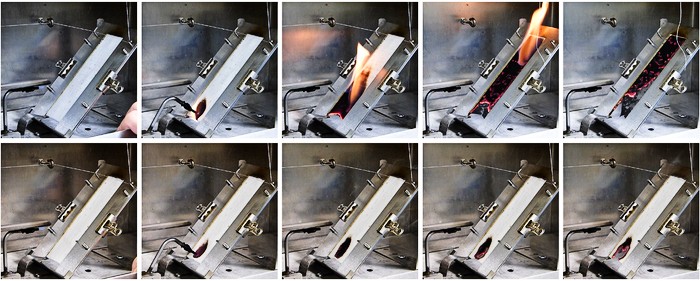Researchers at the U.S. Department of Agriculture’s (USDA) Agricultural Research Service (ARS) bred four cotton lines that can be used to make self-extinguishing textiles when exposed to fire and will reduce the need for flame-retardant chemicals to be embedded in consumer products, according to a recent study published in PLOS ONE.
The cotton lines were developed from cultivated cotton varieties and possessed a novel flame-retardant trait. When exposed to an open flame, the fabric from the new cotton lines self-extinguished whereas regular cotton fabric burned entirely in seconds.
“Use of these lines to develop commercial cultivars creates an opportunity to improve the safety of cotton products while reducing the economic and environmental impacts of chemical flame retardants,” said Brian Condon, senior author of the study and retired research leader at the ARS Cotton Chemistry and Utilization Research Unit in New Orleans. “These lines will significantly benefit growers, producers, and consumers.”
Cotton typically produces flammable fibers and is treated with chemicals to be flame retardant when used for consumer products like clothing, mattresses, upholstery, and carpet. The new cotton lines were created by a multi-parent breeding approach that resulted in new opportunities for natural genes to interact and develop the unexpected trait of flame retardancy.
During a standard 45° incline flammability test, regular cotton (top) burned instantly when exposed to an open flame. In the same test, the fire-resistant cotton (bottom) self-extinguished when exposed to an open flame. (Video by Doug Hinchliffe)
ARS researchers Johnie Jenkins and Jack C. McCarty, supervisory research geneticists at the ARS Genetics and Sustainable Agriculture Research Unit in Mississippi, bred cotton lines to identify genes that affect agronomic traits such as yield and pest resistance and fiber quality traits such as length, strength, and fineness.
“ARS scientists study every step of cotton production from ‘Dirt to Shirt’ including genetic diversity, field management practices, fiber quality attributes, and end-use textile characteristics,” said Jenkins.
Although all of the parental cotton lines produced flammable fabric, researchers found that flame retardance did not come from a single gene. Instead, they found that multiple genes created a phenotype for fibers with significantly lower heat release capacities. The new cotton lines also possessed the desired agronomic and fiber quality traits, making the lines sought after for breeding and consumer usage.
“We look at fabric quality and chemical finishes that create permanent press, wrinkle-free, and flame-retardant fabrics. Now we have found lines with a novel and natural genetic mechanism for flame retardance,” said Condon.
The Agricultural Research Service is the U.S. Department of Agriculture’s chief scientific in-house research agency. Daily, ARS focuses on solutions to agricultural problems affecting America. Each dollar invested in U.S. agricultural research results in $20 of economic impact.

